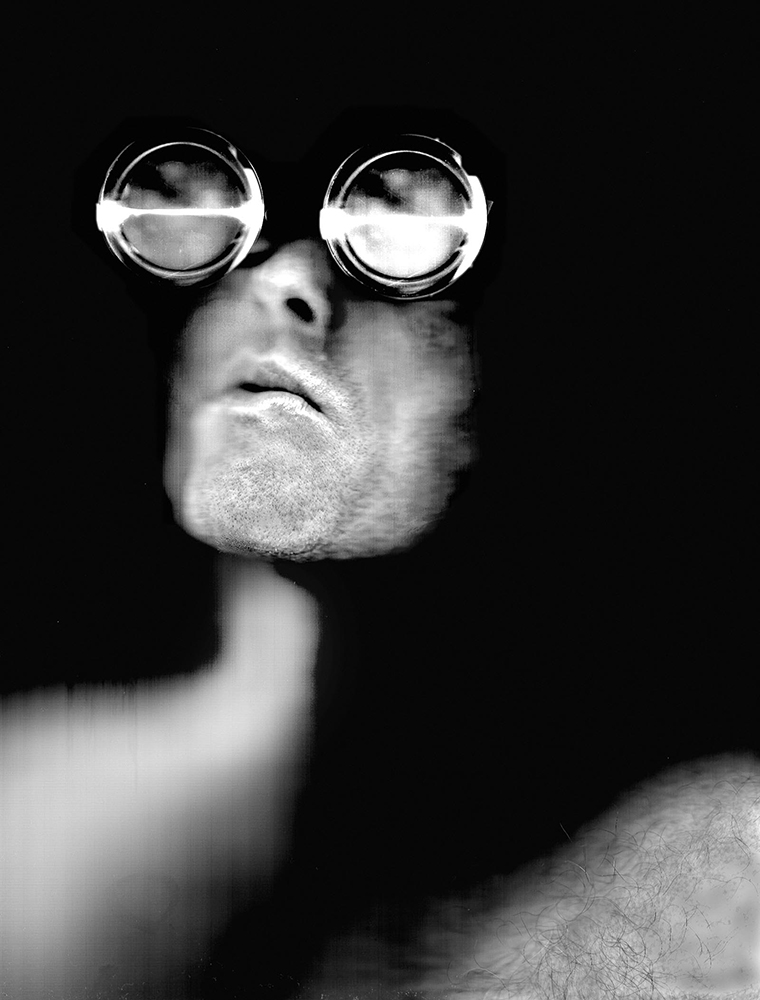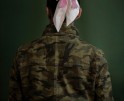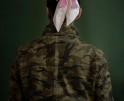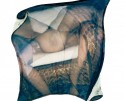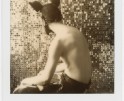Inner Vision: Photography by Blind Artists: Kurt Weston
Losing the Light illustrates the visual obstructions that I experience in my own vision. To achieve this, I use a flatbed computer scanner and spray foaming glass cleaner onto the scanning glass. I then streak the foaming glass cleaner with my hand and then lay my head and hand onto the scanning glass. I try to streak the glass to illustrate the desire that I have, to wipe away these visual obstructions. The foaming glass cleaner accumulates around my fingers and streaks the glass as I move my hand. My head in profile on the opposite side of the glass. Using this technique is rather cumbersome in that it does take a while for the scanning device to scan my face and hand, as I lay them on the glass. The chemicals in the foaming glass cleaner are rather pungent, so it’s very difficult to breathe. And many times, I have to hold my breath in order not to smell the chemicals; but also, to avoid steaming of the glass because any breath condensates on the glass and sometimes causes the definition of the face to be obscured. But it is a very difficult photographic process, and it does represent my vision that I have these floaters, which obstruct my vision. So, it does illustrate all these aspects of that particular part of my vision impairment
Kurt Weston is an artist working primarily with photography and photo-based art. He was diagnosed with AIDS in 1991 and became legally blind in 1996 due to a related condition, Cytomegalovirus retinitis. During this time he was easily identified as having AIDS due to purplish red lesions—Kaposi’s sarcoma—all over his face and body. His artwork reflects on this experience of visibility and disability, examining cultural stigmas surrounding HIV and AIDS, the disabled body, mortality, and loss. Weston’s photographs are in the collections of the Museum of Fine Arts, Houston, the Museum of Contemporary Photography and the National AIDS Museum and have been featured in exhibitions at the Kennedy Center for the Arts (Washington, DC), the Berkeley Art Museum (Berkeley, CA), the California Museum of Photography (Riverside, CA) and the Orange County Center for Contemporary Art (Santa Ana, CA), among others.
Kurt’s three images are from his Blind Vision series reflecting on the artist’s bitter battle to stay in this world as a long-term survivor of AIDS who has lost his vision to CMV retinitis. These experimental self-portraits evoke the dissolution and fragmentation of the artist’s body. They represent the impact of blindness, long-term HIV infection, and the cumulative effects of decades of antiretroviral medication.
The captions are audio descriptions and each is accompanied by a recording.
Can You See the Big E is a photograph framed in the context of an ophthalmological eye examination. It’s a portrait of me, again, using the scanner as camera and I am seen with my head tilted back with very large magnification devices over my eyes – very large lenses. I’m staring out at something, and what I’m staring at is an ophthalmological eye chart which typically has alphabetical letters in varying sizes, with the letter E very large and bolded at the very top of the chart. I cannot even see the letter E on an eye chart. And so, the technicians usually have to hold their hand in front of my face and show me different fingers and have me count fingers about two inches from my eyes just to see if I have any useable vision even at close proximity. I use those large lenses over my eyes to illustrate the magnification devices that I have to use, in order to see just even a little bit. And these large magnification lenses typically are very awkward and cumbersome while I have to wear them to scan and view things. I see these as being in many ways as a visual prosthetic. And they are always very necessary for me, in order for me to even read any type of document or see any type of detail.
The Image Fix is a somewhat disturbing image. It’s a portrait of me with my head turned in a three-quarter view and a syringe filled with medication in my hand. The syringe needle is touching the cornea of my left eye and I am pushing down with my thumb on the plunger of the syringe to inject medication into the eye. I have in the experience of my different eye impairments had to have medications injected directly into my eye and it is really a very, very disturbing experience. Typically, the doctor will ask me to turn my eyes to gaze in one direction, while he puts the syringe and the needle right into the opposite part of my eyeball and injects medication. It’s very, very frightening and it’s not a pleasant experience in the least. I entitled this image The Image Fix in some ways to play off the concept of the drug culture, which uses the terminology of using drugs as a fix. And in some ways, this is a fix for my vision. The hope is that the medication will save what is left of my vision so that I won’t lose any more and it is a sort of a fix in terms of my prevention of more vision loss. I guess, whatever it takes to keep whatever remaining sight that I have left.
Posts on Lenscratch may not be reproduced without the permission of the Lenscratch staff and the photographer.
Recommended
-
Kyle Agnew | Our Cheeks Blush Amidst Prairie GrassesMay 10th, 2024
-
Andres Pérez: Familia Muerta / Patria MuertaMay 9th, 2024
-
Andrés Pérez: Dead Family / Dead HomelandMay 9th, 2024
-
Once-Taboo: Tynan Byrne’s Polaroids of Bonding and BrotherhoodMay 8th, 2024
-
Cris Gomez’s Polaroids: Being Queer & The Fear of Losing EverythingMay 7th, 2024


